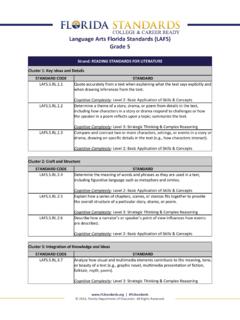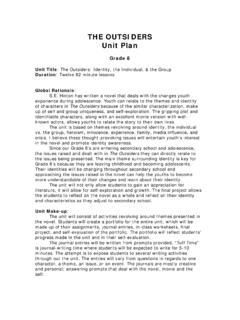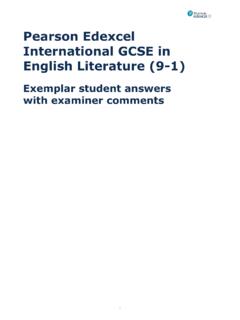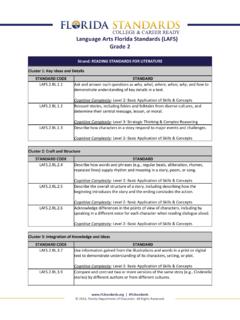Transcription of 2nd Grade English Language Arts Goals and Objectives
1 Walton Academy2nd Grade English Language ArtsGoals and ObjectivesReading: LiteratureKey Ideas and Details Ask and answer such questions as who, what, where, when, why, and how to demonstrate understanding of key details in a text. Recount stories, including fables and folktales from diverse cultures, and determine their central message, lesson, or moral. Describe how characters in a story respond to major events and and Structure Describe how words and phrases ( , regular beats, alliteration, rhymes, repeated lines) supply rhythm and meaning in a story, poem, or song.
2 Describe the overall structure of a story, including describing how the beginning introduces the story and the ending concludes the action. Acknowledge differences in the points of view of characters, including by speaking in a different voice for each character when reading dialogue of Knowledge and Ideas Use information gained from the illustrations and words in a print or digital text to demonstrate understanding of its characters, setting, or plot. compare / contrast two or more versions of the same story ( , Cinderella stories) by different authors or from different cultures.
3 Range of Reading and Level of Text Complexity By the end of the year, read and comprehend literature, including stories and poetry , in the grades 2 3 text complexity band proficiently, with scaffolding as needed at the high end of the : Informational TextKey Ideas and Details Ask and answer such questions as who, what, where, when, why, and how to demonstrate understanding of key details in a text. Identify the main topic of a multiparagraph text as well as the focus of specific paragraphs within the text.
4 Describe the connection between a series of historical events, scientific ideas or concepts, or steps in technical procedures in a and Structure Determine the meaning of words and phrases in a text relevant to a Grade 2 topic or subject area. Know and use various text features ( , captions, bold print, subheadings, glossaries, indexes, electronic menus, icons) to locate key facts or information in a text efficiently. Identify the main purpose of a text, including what the author wants to answer, explain, or of Knowledge and Ideas Explain how specific images ( , a diagram showing how a machine works) contribute to and clarify a text.
5 Describe how reasons support specific points the author makes in a text. compare / contrast the most important points presented by two texts on the same of Reading and Level of Text Complexity By the end of year, read and comprehend informational texts, including history/social studies, science, and technical texts, in the grades 2 3 text complexity band proficiently, with scaffolding as needed at the high end of the : Foundational SkillsPhonics and Word Recognition - Know and apply Grade -level phonics and word analysis skills in decoding words.
6 Distinguish long and short vowels when reading regularly spelled one-syllable words. Know spelling-sound correspondences for additional common vowel teams. Decode regularly spelled two-syllable words with long vowels. Decode words with common prefixes and suffixes. Identify words with inconsistent but common spelling-sound correspondences. Recognize and read Grade -appropriate irregularly spelled Read with sufficient accuracy and fluency to support comprehension. Read Grade -level text with purpose and understanding.
7 Read Grade -level text orally with accuracy, appropriate rate, and expression on successive readings. Use context to confirm or self-correct word recognition and understanding, rereading as Types and Purposes Write opinion pieces in which they introduce the topic or book they are writing about, state an opinion, supply reasons that support the opinion, use linking words ( , because, and, also) to connect opinion and reasons, and provide a concluding statement or section. Write informative/explanatory texts in which they introduce a topic, use facts and definitions to develop points, and provide a concluding statement or section.
8 Write narratives in which they recount a well-elaborated event or short sequence of events, include details to describe actions, thoughts, and feelings, use temporal words to signal event order, and provide a sense of and Distribution of Writing With guidance and support from adults and peers, focus on a topic and strengthen writing as needed by revising and editing. With guidance and support from adults, use a variety of digital tools to produce and publish writing, including in collaboration with to Build and Present Knowledge Participate in shared research and writing projects ( , read books on a single topic to produce a report; record science observations).
9 Recall information from experiences or gather information from provided sources to answer a and ListeningComprehension and Collaboration Participate in collaborative conversations with diverse partners about Grade 2 topics and texts with peers and adults in small and larger groups. Follow agreed-upon rules for discussions ( , gaining the floor in respectful ways, listening to others with care, speaking one at a time about the topics and texts under discussion). Build on others talk in conversations by linking their comments to the remarks of others.
10 Ask for clarification and further explanation as needed about the topics and texts under discussion. Recount or describe key ideas or details from a text read aloud or information presented orally or through other media. Ask and answer questions about what a speaker says in order to clarify comprehension, gather additional information, or deepen understanding of a topic or of Knowledge and Ideas Tell a story or recount an experience with appropriate facts and relevant, descriptive details, speaking audibly in coherent sentences.








